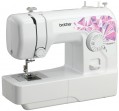Number of stitches
The number of stitches that a sewing machine can sew. The larger this number, the more extensive the capabilities of this model, the wider the choice the user has; however, it wouldn’t hurt to clarify the specific range of supported stitches separately.
The fewest options - mostly up to 25 - are provided in electromechanical machines, as well as specialized devices such as overlockers and carpet lockers (see “Type”). In computer-controlled devices, the number of lines can be in the dozens, and some also allow you to download additional options from the computer.
Number of loops
The number of welt stitches that a sewing machine can make. Different types of loops are used for different types of fabrics and clothing. The larger this number, the wider the choice the user has and the less likely it is that the machine’s arsenal will not have the required type of loop.
Features
—
Вышивание букв алфавита. Возможность вышивания букв алфавита с помощью машинки. Данная функция встречается в моделях с компьютерным управлением, она осуществляется за счет набора букв, занесенного в память машинки. Многие модели с такой возможностью имеют несколько встроенных шрифтов, а некоторые даже позволяют загружать свои шрифты с компьютера.
—
Дифференциальный транспортер. Транспортер для ткани, состоящий из двух зубчатых реек — перед и за иглой. В зависимости от выставленного режима такой транспортер может дополнительно растягивать или, наоборот, собирать ткань во время шитья; первое пригодится при работе с плотными тканями, второе — для трикотажа, стрейча и других легко тянущихся материалов.
—
Реверс. Функция, позволяющая переключать направление движения ткани под иглой и, соответственно, направление шва. Применяется в основном для закрепления строчки. Реверс является практически обязательным для швейных машин в классическом смысле слова — электромеханических, компьютеризированных и швейно-вышивальных (см. «Тип»), а вот в других типах практически не встречается.
— Рукавная платформа. Приспособление для работы с рукавами, штанинами и прочими аналогичными деталями одежды. Эта функция чаще всего реализуется за счет съемной части рабочего столика — при ее снятии столик превращается в узкую платформу. Конкретная ширина такого прис
...пособления может быть разной, ее стоит уточнять отдельно.
— Нитевдеватель. Специальное приспособление, предназначенное для того, чтобы облегчить процесс вдевания нитки в иголку. Наличие нитевдевателя особенно полезно при частной смене ниток (например, шитье попеременно разными цветами).
— Нитеобрезатель. Механизм для обрезания нитей после окончания шитья, избавляющий от необходимости использовать ножницы: для обрезания нитки достаточно нажать кнопку. Отметим, что речь идет именно об автоматическом нитеобрезателе; ручные приспособления, устанавливаемые на корпуса некоторых машинок, в данном случае нитеобрезателями не считаются.
— Шитье без педали. Возможность использовать машинку без подключения педали. Для запуска и остановки процесса в таких моделях, как правило, предусматривается специальная кнопка. Подобная возможность может пригодиться при длительном шитье, когда держать педаль постоянно нажатой было бы утомительно, и при эпизодическом использовании, когда машинка запускается «на пару стежков» и возиться с подключением педали особо незачем.
— Шитье двойной иглой. Возможность применения машинки для шитья двойной иглой — парой игл, закрепленных в одном держателе. Существуют разные виды таких игл и разные приемы работы с ними, а некоторые работы выполняются только двойной иглой. В любом случае для использования подобных приспособлений требуется, чтобы машинка была изначально с ними совместима.
— Позиционирование иглы (верх/низ). Переключатель, позволяющий пользователю выбрать, в каком положении будет находиться игла после остановки двигателя — верхнем или нижнем. При отсутствии такого выключателя игла, как правило, останавливается только в верхнем положении, а это не всегда удобноLed lighting
Встроенная система подсветки, освещающая рабочий столик машинки, которая выполнена на светодиодах. Помимо яркого освещения области работы
швейные машинки с LED подсветкой еще имеют пониженные на фоне классических ламп показатели энергозатрат.
Cover
The type of cover supplied with the sewing machine.
-
Soft. A soft fabric cover protects the machine mainly from dust and dirt and provides almost no protection from bumps and collisions. At the same time, having removed such a cover for the duration of work, it can be folded compactly.
-
Hard. A cover in the form of a hard cover put on from above or a case in which the machine fits. Such a cover is rather bulky, it cannot be folded like a soft one; on the other hand, it protects the machine well both from dirt and from collisions and contact with solid objects.

